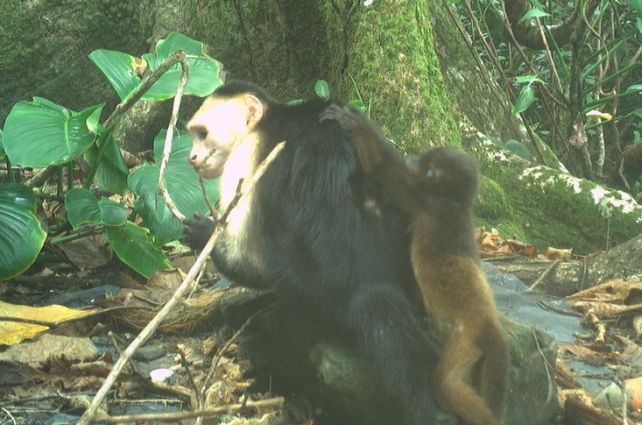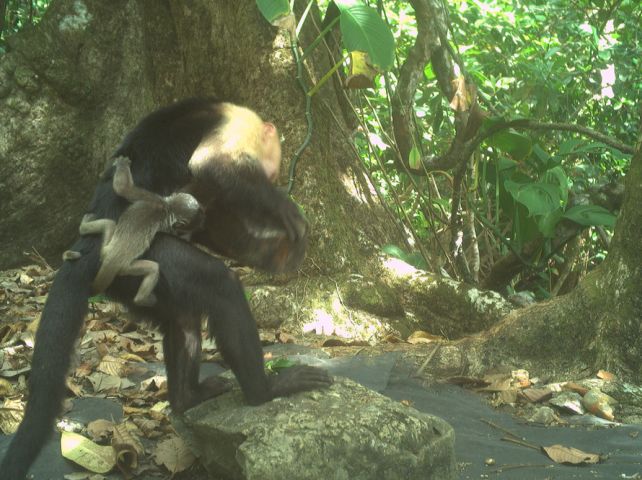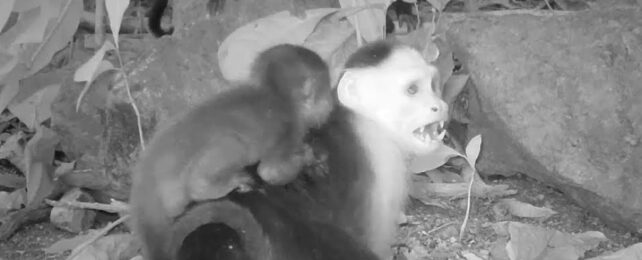Off the coast of Panama, on an island uninhabited by humans, a culture unlike any other has arisen.
On Jicarón Island, white-faced capuchin monkeys (Cebus capucinus imitator) rule, unmolested by predators. In their peace, and safety, they exhibit fascinating behaviors, wielding stone tools to facilitate their foraging in a way that may have once been thought unique to humans.
Now, the monkeys have taken their shenanigans a step further. They have been caught doing something that scientists had never seen before: kidnapping the babies of howler monkeys (Alouatta palliata coibensis) and carrying them around like some sort of bizarre accessory.
After poring and puzzling over the observations, a team led by behavioral ecologist Zoë Goldsborough of the Max Planck Institute of Animal Behavior concluded nothing explained the behavior as aptly as a fashion, or fad.

"Scientists continue to uncover evidence of culture across animal taxa, and a behavior is considered cultural if it spreads between individuals via social learning," Goldsborough told ScienceAlert. "The howler-carrying behavior we describe is indeed part of this capuchin group's culture."
Fads are not commonly identified in non-human animals. Examples include the peculiar intermittent salmon hats sported by orcas, and chimpanzees in Zambia wearing grass in their ears. These 'fads' are behaviors that the animals learn from each other, and serve no discernible purpose, like … planking, for example.
Goldsborough and her colleagues had set up camera traps around Jicarón to monitor the capuchins' fascinating tool use. The scientists first got wind that something strange was going on with the monkeys when one individual, named Joker, was spotted going about his business with a baby howler monkey clinging to his fur.

"It was so weird that I went straight to my advisor's office to ask him what it was," Goldsborough says in a statement. Alerted that shenanigans were indeed afoot, the researchers started paying closer attention. Goldsborough studied data collected by the camera traps, and found evidence of Joker carrying, at different times, four different baby howler monkeys.
Then, it got weirder. Several months later, the behavior re-emerged. At first, the team thought Joker was resuming his strange hobby – but then they realized different capuchins were getting involved. In total, their observations over a 15-month period found five capuchins (including Joker) carrying 11 different howler monkey babies.
At first, the puzzled scientists thought that the capuchins might be adopting the babies. But interspecies adoption is rare, and usually conducted by females. All five of the howler-carrying capuchins were males. In addition, the capuchins didn't seem interested in caring for the babies – all are assumed to have eventually died of starvation, with four confirmed dead.

"The capuchin carriers do not seem to interact with the howler infants a lot besides carrying them. So they do not play with them, or try to groom them," Goldsborough explained to ScienceAlert.
"To me, it appears less as if they want to keep the howler infant because they are so interested in them and interacting with them, but more that they carry them as an 'accessory' and are interested in the carrying behavior."
But that's only part of the equation. There's the question of why are the capuchins carrying howler babies; the other question is, why these capuchins, and only these capuchins?
"This is a fascinating question, since howler monkeys and capuchin monkeys co-occur in most of their ranges, and often interact, but never like this," Goldsborough said.
Interestingly, the answer appears to be simple boredom. The capuchin population on Jicarón has no predators, and few competitors. They live a pretty cushy, relaxed life and may be somewhat understimulated, the researchers hypothesize – a lifestyle that has been linked to innovation in humans and other animals.
"We think the conditions on Jicarón Island, specifically the lack of terrestrial predators and potentially greater amount of free time, are very conducive to the innovation and spread of behaviors," Goldsborough explained.

The researchers plan to continue investigating this behavior to see if it evolves, or other fads emerge. Goldsborough also noted that she'd like to learn more about how the howler monkeys are responding to it.
Until a handful of shit-stirring capuchins decided their babies might make dapper accoutrements, they were also living in a predator-free environment. Now, their babies lives' are being threatened.
There may also be some fascinating philosophical insights to be gleaned.
"One of the reasons our discovery elicits such interest is because it provides a mirror into ourselves. Humans often try to compare ourselves to other animals to find similarities and differences, and this is usually focused on positive qualities (e.g., language, tool use, empathy)," Goldsborough said.
"However, if you think about it, humans have many seemingly arbitrary cultural traditions that harm other species. Finding that this type of culture is not limited to humans, but might also occur in other intelligent animals living in the right conditions, is a fascinating implication of our findings."
The research has been published in Current Biology.
You can also explore the documented rise and spread of the behavior on an interactive website here.
